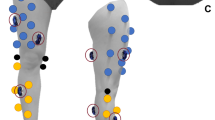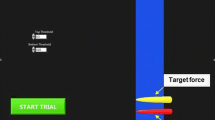Abstract
Purpose
The main purpose of this study was to describe the nature of the relationship between hamstring muscle activity and anterior knee laxity.
Methods
This was a cross-sectional study. Anterior knee laxity was measured at 133N and manual maximal forces using the KT2000 knee arthrometer, in 8 ACL-injured and 13 uninjured individuals. Electromyographic activity of the lateral hamstrings was measured during laxity testing. Subjects contracted the hamstrings during anterior knee laxity testing at eight predetermined levels of maximal voluntary isometric contraction.
Results
Volitional contraction of the lateral hamstrings reduced anterior knee laxity logarithmically for both the 133N and manual maximal tests in both the ACL-injured and uninjured knees. A simple linear regression model, with the log of percentage of maximum lateral hamstrings activity as the sole predictor, explained approximately 70–80 % of the variation in anterior knee laxity. Both ACL-injured and uninjured subjects reduced anterior knee laxity at the same rate with increases in muscle activity. However, initial lateral hamstrings muscle activity had a greater effect on percentage anterior knee laxity scores in the ACL-injured as compared to the uninjured knee.
Conclusions
Lateral hamstrings activity reduces anterior knee laxity in a nonlinear manner, whereby the initial lower level of activation produces the greatest change in anterior knee laxity. Therefore, hamstrings muscle activity must be monitored during anterior knee laxity testing.





Similar content being viewed by others
References
Bach BR, Warren RF, Flynn WM, Kroll M, Wickiewiecz TL (1990) Arthrometric evaluation of knees that have a torn anterior cruciate ligament. J Bone Joint Surg Am 72(9):1299–1306
Bagger J, Ravn J, Lavard P, Blyme P, Sorensen C (1992) Effect of functional bracing, quadriceps and hamstrings on anterior tibial translation in anterior cruciate ligament insufficiency: a preliminary study. J Rehabil Res Dev 29(1):9–12
Basmajian JV, DeLuca CJ (1985) Muscles alive: their functions revealed by electromyography, 5th edn. Williams and Wilkins, Baltimore
Berry J, Kramer K, Binkley J, Binkley GA, Stratford P, Hunter S, Brown K (1999) Error estimates in novice and expert raters for the KT-1000 arthrometer. J Orthop Sports Phys Ther 29(1):49–55
Cannon WD (2002) Use of arthrometers to assess knee laxity and outcomes. Sports Med Arthrosc Rev 10(3):191–200
Cram JR, Kasman GS, Holtz J (1998) Introduction to surface electromyography, 1st edn. Aspen Publishers Gaithersburg, Md
Daniel DM, Stone ML, Sachs R, Malcom L (1985) Instrumented measurement of anterior knee laxity in patients with acute anterior cruciate ligament disruption. Am J Sports Med 13(6):401–407
Feller J, Hoser C, Webster K (2000) EMG biofeedback assisted KT-1000 evaluation of anterior tibial displacement. Knee Surg Sports Traumatol Arthrosc 8(3):132–136
Fiebert I, Gresley J, Hoffman S, Kunkel K (1994) Comparative measurements of anterior tibial translation using the Kt-1000 knee arthrometer with the leg in neutral, internal-rotation, and external rotation. J Orthop Sports Phys Ther 19(6):331–334
Fiebert IM, Spielholz NI, Applegate EB, Fox C, Jaro J, Joel L, Raper L (2000) Comparison of EMG activity of medial and lateral hamstrings during isometric contractions at various cuff weight loads. Knee 8:145–150
Flandry F, Hunt JP, Terry GC, Hughston JC (1991) Analysis of subjective knee complaints using visual analog scales. Am J Sports Med 19(2):112–118
Fleming BC, Brattbakk B, Peura GD, Badger GJ, Beynnon BD (2002) Measurement of anterior-posterior knee laxity: a comparison of three techniques. J Orthop Res 20(3):421–426
Forster IW, Warrensmith CD, Tew M (1989) Is the Kt1000 knee ligament arthrometer reliable. J Bone Joint Surg Br 71(5):843–847
Graham GP, Johnson S, Dent CM, Fairclough JA (1991) Comparison of clinical tests and the KT1000 in the diagnosis of anterior cruciate ligament rupture. Br J Sports Med 25(2):96–97
Gross SM, Carcia CR, Gansneder BM, Shultz SJ (2004) Rate of force application during knee arthrometer testing affects stiffness but not displacement measurements. J Orthop Sports Phys Ther 34(3):132–139
Hermens HJ (1999) European recommendations for surface electromyography: results of the seniam project, vol 1st. Roessingh Research and Development
Highgenboten CL, Jackson A, Meske NB (1989) Genucom, KT-1000, and Stryker knee laxity measuring device comparisons. Am J Sports Med 17(6):743–746
Irrgang JJ, Anderson AF, Boland AL, Harner C, Kurosaka M, Neyret P, Richmond JC, Shelborne D (2001) Development and Validation of the International Knee Documentation Committee Subjective Knee Form. Am J Sports Med 29(5):600–613
Iversen BF, Sturup J, Jacobsen K, Andersen J (1989) Implications of muscular defense in testing for the anterior drawer sign in the knee: a stress radiographic investigation. Am J Sports Med 17(3):409–413
Jonsson H, Karrholm J, Elmqvist LG (1993) Laxity after cruciate ligament injury in 94 knees—the Kt-1000 arthrometer versus Roentgen stereophotogrammetry. Acta Orthop Scand 64(5):567–570
Klyne DM, Keays SL, Bullock-Saxton JE, Newcombe PA (2012) The effect of anterior cruciate ligament rupture on the timing and amplitude of gastrocnemius muscle activation: a study of alterations in EMG measures and their relationship to knee joint stability. J Electromyogr Kinesiol 22(3):446–455
Logan MC, Williams A, Lavelle J, Gedroyc W, Freeman M (2004) What really happens during the Lachman test? A dynamic MRI analysis of tibiofemoral motion. Am J Sports Med 32:369–375
MacWilliams BA, DesJardins JD, Wilson DR, Romero J, Chao EYS (1998) A repeatable alignment method and local coordinate description for knee joint testing and kinematic measurement. J Biomech 31(10):947–950
Markolf KL, Graff-Radford A, Amstutz HC (1978) In vivo knee stability. A quantitative assessment using an instrumented clinical testing apparatus. J Bone Joint Surg Am 60(5):664–674
Renstrom P, Arms SW, Stanwyck TS, Johnson RJ, Pope MH (1986) Strain within the anterior cruciate ligament during hamstring and quadriceps activity. Am J Sports Med 14(1):83–87
Robert H, Nouveau S, Gageot S, Gagniere B (2009) A new knee arthrometer, the GNRB: experience in ACL complete and partial tears. Orthop Traumatol Surg Res 95(3):171–176
Scarvell JM, Smith PN, Refshauge KM, Galloway H, Woods K (2005) Comparison of kinematics in the healthy and ACL injured knee using MRI. J Biomech 38(2):255–262
Solomonow M, Baratta R, Zhou BH, Shoji H, Bose W, Beck C, D’Ambrosia R (1987) The synergistic action of the anterior cruciate ligament and thigh muscles in maintaining joint stability. Am J Sports Med 15(3):207–213
Steele JR, Roger GJ, Milburn PD (1994) Tibial translation and hamstring activity during active and passive arthrometric assessment of knee laxity. Knee 1(4):217–223
Tegner Y, Lysholm J (1985) Rating systems in the evaluation of knee ligament injuries. Clin Orthop Relat Res 198:42–49
Wojtys EM, Ashton-Miller JA, Huston LJ (2002) A gender-related difference in the contribution of the knee musculature to sagittal-plane shear stiffness in subjects with similar knee laxity. J Bone Jt Surg Am 84(1):10–16
Yosmaoglu HB, Baltaci G, Ozer H, Atay A (2011) Effects of additional gracilis tendon harvest on muscle torque, motor coordination, and knee laxity in ACL reconstruction. Knee Surg Sports Traumatol Arthrosc 19(8):1287–1292
Zantop T, Herbort M, Raschke MJ, Fu FH, Petersen W (2007) The role of the anteromedial and posterolateral bundles of the anterior cruciate ligament in anterior tibial translation and internal rotation. Am J Sports Med 35(2):223–227
Author information
Authors and Affiliations
Corresponding author
Rights and permissions
About this article
Cite this article
Barcellona, M.G., Morrissey, M.C., Milligan, P. et al. The effect of thigh muscle activity on anterior knee laxity in the uninjured and anterior cruciate ligament-injured knee. Knee Surg Sports Traumatol Arthrosc 22, 2821–2829 (2014). https://doi.org/10.1007/s00167-013-2695-5
Received:
Accepted:
Published:
Issue Date:
DOI: https://doi.org/10.1007/s00167-013-2695-5




